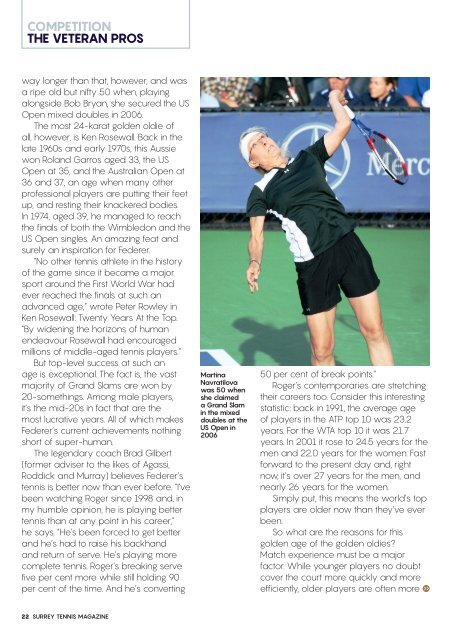Surrey.Tennis 2017/2018
A review of all the activities in Surrey Tennis in 2017/2018 Published by Surrey.Tennis
A review of all the activities in Surrey Tennis in 2017/2018
Published by Surrey.Tennis
You also want an ePaper? Increase the reach of your titles
YUMPU automatically turns print PDFs into web optimized ePapers that Google loves.
competition<br />
the veteran pros<br />
way longer than that, however, and was<br />
a ripe old but nifty 50 when, playing<br />
alongside Bob Bryan, she secured the US<br />
Open mixed doubles in 2006.<br />
The most 24-karat golden oldie of<br />
all, however, is Ken Rosewall. Back in the<br />
late 1960s and early 1970s, this Aussie<br />
won Roland Garros aged 33, the US<br />
Open at 35, and the Australian Open at<br />
36 and 37, an age when many other<br />
professional players are putting their feet<br />
up, and resting their knackered bodies.<br />
In 1974, aged 39, he managed to reach<br />
the finals of both the Wimbledon and the<br />
US Open singles. An amazing feat and<br />
surely an inspiration for Federer.<br />
“No other tennis athlete in the history<br />
of the game since it became a major<br />
sport around the First World War had<br />
ever reached the finals at such an<br />
advanced age,” wrote Peter Rowley in<br />
Ken Rosewall: Twenty Years At the Top.<br />
“By widening the horizons of human<br />
endeavour Rosewall had encouraged<br />
millions of middle-aged tennis players.”<br />
But top-level success at such an<br />
age is exceptional. The fact is, the vast<br />
majority of Grand Slams are won by<br />
20-somethings. Among male players,<br />
it’s the mid-20s in fact that are the<br />
most lucrative years. All of which makes<br />
Federer’s current achievements nothing<br />
short of super-human.<br />
The legendary coach Brad Gilbert<br />
(former adviser to the likes of Agassi,<br />
Roddick and Murray) believes Federer’s<br />
tennis is better now than ever before. “I’ve<br />
been watching Roger since 1998 and, in<br />
my humble opinion, he is playing better<br />
tennis than at any point in his career,”<br />
he says. “He’s been forced to get better<br />
and he’s had to raise his backhand<br />
and return of serve. He’s playing more<br />
complete tennis. Roger’s breaking serve<br />
five per cent more while still holding 90<br />
per cent of the time. And he’s converting<br />
Martina<br />
Navratilova<br />
was 50 when<br />
she claimed<br />
a Grand Slam<br />
in the mixed<br />
doubles at the<br />
US Open in<br />
2006<br />
50 per cent of break points.”<br />
Roger’s contemporaries are stretching<br />
their careers too. Consider this interesting<br />
statistic: back in 1991, the average age<br />
of players in the ATP top 10 was 23.2<br />
years. For the WTA top 10 it was 21.7<br />
years. In 2001 it rose to 24.5 years for the<br />
men and 22.0 years for the women. Fast<br />
forward to the present day and, right<br />
now, it’s over 27 years for the men, and<br />
nearly 26 years for the women.<br />
Simply put, this means the world’s top<br />
players are older now than they’ve ever<br />
been.<br />
So what are the reasons for this<br />
golden age of the golden oldies?<br />
Match experience must be a major<br />
factor. While younger players no doubt<br />
cover the court more quickly and more<br />
efficiently, older players are often more<br />
22 surrey tennis magazine


